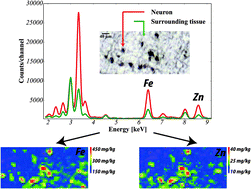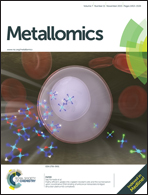Synchrotron radiation based X-ray fluorescence shows changes in the elemental composition of the human substantia nigra in aged brains
Abstract
Human brain aging is considered to be the leading risk factor for a variety of neurodegenerative alterations. In particular, it is thought that the human substantia nigra might play a pivotal role in age-associated dopamine depletion which could be responsible for neuronal demise and subsequent emergence of different neurological alterations. A plethora of neurochemical redox- and non-redox-driven mechanisms is mainly associated with modifications in the elemental composition of both neuromelanin-pigmented neurons and extraneuronal spaces in the human substantia nigra pars compacta (SNpc). An age-associated variation in the content of Fe, Cu, Zn and Ca has recently received great interest in neurology, as these elements are implicated in different biochemical mechanisms underlying malicious neurodegenerative disorders, including Parkinson's and Alzheimer's diseases. Interestingly, to the best our knowledge, there is lack of a comprehensive study on age-associated variation in the elemental composition of the human SNpc. In that respect, the aim of the present study was to make a preliminary attempt to unravel some of the age-associated mechanisms responsible for the metabolism of some redox-active and redox-inactive elements in the elderly. To do so, substantia nigra tissue specimens, drawn from 37 individuals who deceased without any signs of neurodegeneration, were subjected to spectroscopic studies using synchrotron radiation based X-ray fluorescence. Both neuromelanin-pigmented neurons and extraneuronal areas were studied. It appears that in the neurons, Fe tends to decrease, whilst Cu, Zn and Ca were found to accumulate as an individual gets older.

- This article is part of the themed collection: Alzheimer's Research Month 2016

 Please wait while we load your content...
Please wait while we load your content...